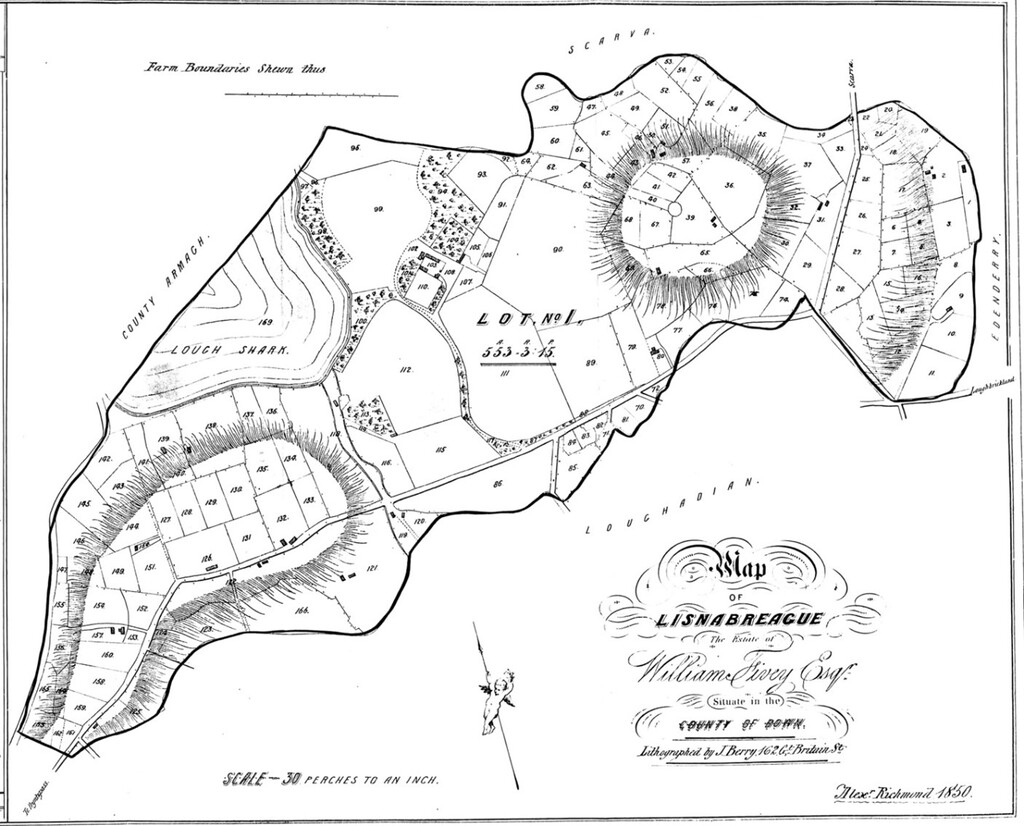Alexander Richmond (1787-1867) was a civil engineer, surveyor, cartographer, and valuer, and probably best known for producing the 1831 map of the Acton Estate.
In 1808, he joined the Corps of Royal Sappers and Miners, which is presumably where he got most of his civil engineering training. He left the army in 1817, aged about 30, and seems to have moved almost immediately to the area, as his name is recorded in the May 1817 rent book of the Close Estates.
The first appearance of his name in newspapers is in a June 1833 advert, where he signs himself as Surveyor to the trustees of the Lisburn and Monaghan Turnpike Road (today’s A3) which had been established in 1828. He also appears in 1838, as one of the many hundreds of signatories of the rather sycophantic “Address To the Right Honourable Archibald Earl of Gosford”.
He also worked much further afield – PRONI document D/1018/A/2 is a map and survey of part of the townland of Strews in County of Tyrone, estate of the late George Hill Esq., which he produced in 1833.

In 1850, he produced the maps in the documents pertaining to the sale of William Fivey’s estate (Lisnabrague and Edenderry) by The Commissioners For The Sale of Encumbered Estates. In the latter months of this sale process, the name of David Richmond, his oldest son, also appeared in the ‘for sale’ adverts. “CE” (Civil Engineer) is appended to both names in 1853. Alexander’s name also appears as the surveyor in adverts in 1858 for the procurement of “several thousand tons of stones” for the repair of the road from Newry to Charlemont.
Like most of his middle-class contemporaries, he was also a farmer. His name appears on the 1828-35 Tithe Applotment Books as holding land in Brannock and Federanagh.
Alexander was a well-off man by the standards of the time when he died in November 1867; his probate valuation was “under £4,000” – i.e. somewhere between £3,000-4,000.
David Richmond (1826-1903)
David was Alexander’s eldest son. He served as his father’s assistant for three years and then obtained a BA from Trinity College, Dublin. He was in private practice from 1849 to 1855, specialising in water infrastructure. In the early 1850s, his name started to appear alongside (and then instead of) that of his father in newspaper ‘estate for sale’ adverts. A March 1853 advert specifically mentions David as being the Receiver for the sale of William Fivey’s Loughadian estate.
On July 4th, 1854, David and his brother William appeared at Poyntzpass Petty Sessions, charged in connection with the riotous Orange march that had taken place late in the evening of 23rd June (The Poyntzpass Riots) but the charges were dismissed.
In 1855, David travelled to India where he became an Assistant Engineer on the Bombay, Baroda and Central Indian Railway[1]. The company had just been founded that same year, so David’s job presumably involved the initial planning and construction (completed in 1864). He was elected as a member of the Institute of Civil Engineers in 1868. In 1873, by then the railway’s Deputy Chief Engineer, he retired, at the young age of 47, and returned to Co. Down.
He died in Warrenpoint in 1903.
[1] Bombay is now Mumbai and Baroda is now Vadodara. They are about 240 miles apart, so it was a major project.